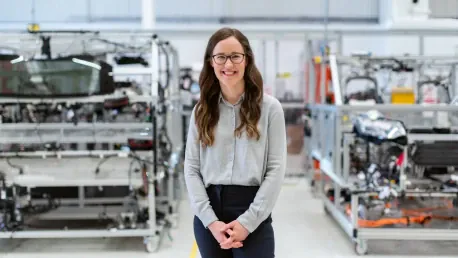Listen to the Article
The life sciences industry has come a long way since the last COVID-19 outbreak. Today, organizations are prioritizing efficiency, speed, and innovation.
That’s why biopharma and biotech companies are increasingly broadening their investments in physical spaces. Campuses and facilities are being redesigned to be more sustainable, adaptable, and employee-friendly while integrating cutting-edge technologies.
Biopharma campuses are changing in big ways. With new designs that are flexible, tech-driven, and focused on sustainability, these spaces are built to meet the future. In this article, you’ll explore the need to invest in campuses of the future—and learn how a modern facility enables you to:
- Achieve breakthroughs with modular and flexible operations;
- Infuse sustainability as a core value;
- Leverage innovative technologies;
- Advance employee happiness and productivity;
- Drive success while reducing costs.
Modularity Means Efficiency
The need to shorten production timelines and accelerate production overwhelms decision-makers as they strive to evolve biopharma operations.
To tackle this challenge, Sanofi brought the world’s first modular concept manufacturing facility to Singapore. Modulus can quickly switch between making different vaccines or treatments in just a few days, while traditional facilities take weeks or months. It can also make up to four vaccines or biopharmaceuticals at once.
Sanofi said in a release that the plant could greatly improve pandemic preparedness. These designs focus on both efficiency and resilience. During public health crises, modular facilities can quickly switch from making standard drugs to producing new treatments, like mRNA-based therapies. This flexibility helps companies respond fast to global health needs and stay competitive in a changing market.
Sustainable, Responsible, and Profitable
The healthcare sector is responsible for about 5% of global greenhouse gas emissions, with half of that coming from supply chains. CEOs from Roche, GSK, and AstraZeneca, along with others, signed an open letter asking suppliers to commit to climate and sustainability goals.
Circularity and life cycle assessment are key to sustainability in the pharmaceutical industry, helping companies use resources better, reduce waste, and lower environmental impact. However, to make circularity work, it’s important to understand how manufacturing processes affect the environment. This includes looking at materials, goods, and waste (solid, liquid, and gas).
Additionally, lab spaces are one of the fastest-growing types of commercial real estate—but they use 10x more energy than similar-sized offices. As the industry grows, efforts are increasing to reduce energy use and create energy-efficient labs, like all-electric facilities and on-site energy generation.
The following table explores how facility design can support sustainability by maximizing reuse and recycling, including the strategies, operational practices, and technologies that can be used.
Modern Technology Nurtures Life Sciences Excellence
Technology is turning biopharma campuses into smart facilities. IoT devices, AI, and automation are improving operations with real-time monitoring, advanced analytics, and predictive maintenance. Businesses that use AI and automation can predict when equipment needs maintenance, reduce downtime, and avoid delays.
Smart facilities also boost regulatory compliance with better traceability and quality control. These innovations are making production more efficient and creating new opportunities for the future of biopharma. More companies now see that facilities management can help fix these problems and add value. Letting experts handle facilities management lets businesses focus on science and research.
In a Question and Answer session, Kevin Wayer, president of JLL’s Life Sciences Work Dynamics practice, explained how biotech, pharma, and medical device companies can benefit from facilities management—and unlock the full power of modern technology.
It’s essential to select a modern, digital facility that enables you to:
- Improve security;
- Increase productivity;
- Make compliance easier;
- Meet higher quality standards;
- Get products to market quicker.
Employee Happiness Matters
Biopharma campuses today focus on their workers. Companies know happy employees are more innovative, so they design spaces that support health, comfort, and teamwork. These campuses include features like natural light, plants, better air systems, and comfortable workstations.
Teamwork spaces boost creativity, and flexible designs work well for hybrid jobs, which are now common after the pandemic. This also helps companies hire and retain the best talent. By creating good workplaces, biopharma companies can improve both productivity and employee satisfaction.
Flexible working needs more adaptable spaces, like desks in coworking places for in between meetings or small offices to reduce travel time. “We’re seeing landlords create their own flexible space or partner with flexible space operators to meet workforce demand and new working and living patterns,” says Hannah Sherwin, Head of EMEA Flex Advisory at JLL.
In life sciences offices, spaces are becoming more versatile. Offices are being changed to have areas for collaboration, private work, or relaxation. Since many offices don’t have enough meeting rooms, it can be hard to manage group meetings, private talks, or urgent emails. The move to flexible workspaces helps employees use their time and space better.
Decentralized Hubs as a Core Advantage
The COVID-19 pandemic showed weaknesses in global supply chains, making biopharma companies rethink how they manufacture products. As a result, decentralized and regional hubs are becoming more popular because they allow companies to make products closer to where they are needed.
This reduces the need for international shipping, speeds up delivery, and gives companies more control. These hubs also help in emerging markets, where they can meet specific healthcare needs while keeping costs low. They ensure essential therapies are available, even during global disruptions. As more companies use this model, decentralized manufacturing is likely to play a bigger role in biopharma’s future.
Conclusion
Biopharma campuses are changing to focus more on being sustainable, flexible, and innovative.
Modular buildings, green technology, smart systems, designs that focus on employees, and local manufacturing are wise moves to address the industry’s changing needs.
By adopting these changes, biopharma companies are creating a future that works well, is strong, and meets global needs. The future of biopharma is bright, and the changes happening now are setting the stage for breakthroughs that will help patients, workers, and the planet.









